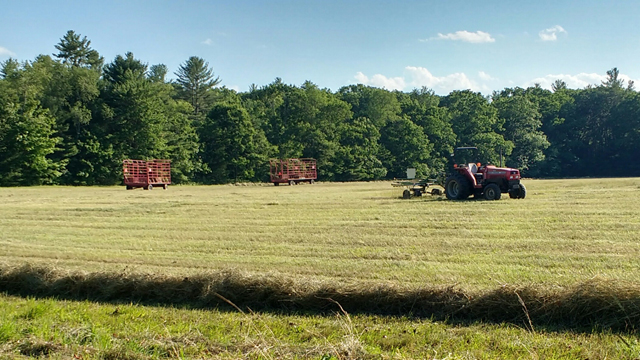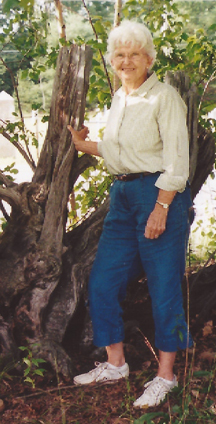
The field across from Lake View Cemetery corner has been a landmark for travelers coming into East Andover for generations. It might just be one of the oldest consistently farmed fields in town.
It has been in the Thompson family since the late 1800s. Ernest Bertelle and Stella Thompson, who lived at the Homestead on Maple Street, passed it to their son, Alan K. Thompson, and his wife Florence after Stella died in 1968. Alan farmed it for many years and used his horse-drawn sickle bar to cut the hay.
About 40 years ago, the Shaw family took over its use. There were some years that corn was planted. This past July, Emile Shaw reports that he got 700 bales of hay off of it. He will most likely get another cutting this year.

In 2008, owned by the Thompson LLC, part of the original field was given to the Town of Andover to make more room in the cemetery. The State of New Hampshire Department of Transportation had redesigned the bad corner in Route 11, cutting through a large part of the field. It made sense to the Thompson LLC trustees to give to the Town the section of the field that was now on the cemetery side of the redesigned road.
The Shaws continued to hay the remaining field. However, in 2013 the Thompson LLC wanted to dissolve and put the field on the market. The future of this old field was uncertain.
Carolyn Thompson Currier, youngest daughter of Alan and Florence, decided that she would purchase the field from the Thompson LLC in order to preserve it for the enjoyment of the generations to come.

Carolyn writes, “As I look at the field being mowed, it brings back happy memories from the 1940s. It was during World War II, when many people from Andover were in the armed services. Farm help was scarce. My two sisters and I helped hay the fields. Before my dad went out to hay, I would pedal the old grindstone while he sharpened the mower’s blade.
“We would rake the hay into rows with Nellie, our dappled gray horse, in the lead. The big wooden bull rake came in handy when picking up the scatterings. We didn’t have a hay baler. The three of us all learned to drive the truck and wagon.
“After heaping the hay into piles and loading the wagon high and wide, we were off to the barn at the Homestead on Maple Street. On our way, we would stop for a cold drink at Stebbin’s Store near the wooden railroad bridge. That was our reward.
“We didn’t get money for our work in the fields. We were a family doing farm work that needed to be done. Dad let us know that we were important, and that gave us the feeling of satisfaction and accomplishment. I remember my father saying, ‘My first three boys were girls.'”
Before Route 11’s Cemetery Corner was redesigned, an old stump fence and tractor shed lined the edge of the field. Even though Route 11 changed the size of the field, it remains a tranquil sight. Wild turkeys, deer, and other wildlife can often be seen within it. When a full moon rises over it, a passerby cannot help but look twice.
In all four seasons, this field displays its changes. For many, it brings back precious memories. My generation and future generations are and will be forever grateful to Carolyn for her desire to preserve this old field.
Donna Baker-Hartwell is Carolyn Currier’s niece.